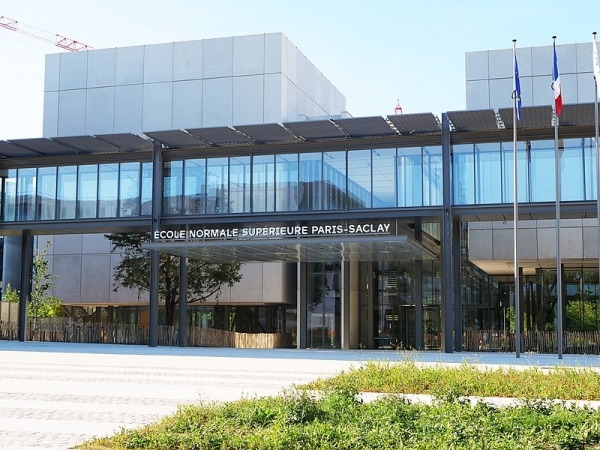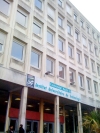Description
Located in the Paris suburb of Cachan, École Normale Supérieure de Cachan (ENS Cachan) is a highly selective university in France, operating outside of the main French university system.
France’s École Normales Supérieures are a subdivision of the Grandes Ecoles system, and there are only four in the country.
The idea behind their creation was to develop establishments to teach and train France’s academic elite after the French Revolution as the country moved towards a meritocratic state. Today, they are widely considered to be among the best in France’s higher education system.
France’s other ENS institutions are in Paris, Rennes and Lyon, and based on student numbers ENS Cachan is the largest.
Students have to pass a competitive entrance exam before being accepted to study in one of ENS Cachan’s three main faculties, which are Science, Engineering, and Social Sciences and Humanities. They are divided into 17 individual departments.
Students who pass the entrance exam are known as normaliens, and they receive a monthly salary during their studies and have to spend six years working for a French public administration once they have completed their studies.
The ENS Cachan campus is home to a number of clubs and associations as well as a library, several resource centres, restaurants and halls of residence.
Among the notable former students of ENS Cachan are Marie-Noelle Lienemann, member of the French Senate for Paris, mathematician Marc Yor, economist Philippe Aghion and physicist Alain Aspect.
Specific details
Location
61, Avenue du Président-Wilson, Cachan , 94235, Ile-de-France, France
Video
News
-
3 étoiles au label "Bienvenue en France" 2025Monday, 10 November 20253 stars with the “Bienvenue en France” label 2025 sylvie.kemenovic Thu, 11/13/2025 - 16:37 In 2025/2026, more than 200 international students chose to study at ENS Paris-Saclay. The label The quality of the welcome given to international students is a fundamental issue for the internationalization and attractiveness of French higher education. The “Bienvenue en France” label is awarded to institutions wishing to highlight their welcome facilities. It is awarded for five years by Campus France and validated by an independent commission. The 23rd certification commission, which met in October 2025, renewed the “Bienvenue en France” label for eight institutions, including ENS Paris-Saclay via the application of Paris-Saclay University. The commission is composed of members of institutional conferences, the CTI, the HCERES, and Campus France, and highlights higher education institutions that offer services to facilitate the studies and stays of international students. The criteria are based on: the quality of support offered to students during their stay; the provision of clear and accessible information and accommodation solutions; the organization of events and activities throughout the year. ri [at] ens-paris-saclay.fr (Servie Relations internationales) Honours - Awards Prix et distinctions Student Academic Media The “Bienvenue en France” label is awarded to universities for their international student welcome programs. In 2025, ENS Paris-Saclay was awarded three stars, a distinction awarded for five years to institutions committed to improving and promoting the welcome given to international students. “Welcome to France” label on the Campus France website
-
3 étoiles au label "Bienvenue en France" 2025Monday, 10 November 20253 stars with the “Bienvenue en France” label 2025 sylvie.kemenovic Thu, 11/13/2025 - 16:37 In 2025/2026, more than 200 international students chose to study at ENS Paris-Saclay. The label The quality of the welcome given to international students is a fundamental issue for the internationalization and attractiveness of French higher education. The “Bienvenue en France” label is awarded to institutions wishing to highlight their welcome facilities. It is awarded for five years by Campus France and validated by an independent commission. The 23rd certification commission, which met in October 2025, renewed the “Bienvenue en France” label for eight institutions, including ENS Paris-Saclay via the application of Paris-Saclay University. The commission is composed of members of institutional conferences, the CTI, the HCERES, and Campus France, and highlights higher education institutions that offer services to facilitate the studies and stays of international students. The criteria are based on: the quality of support offered to students during their stay; the provision of clear and accessible information and accommodation solutions; the organization of events and activities throughout the year. ri [at] ens-paris-saclay.fr (Servie Relations internationales) Honours - Awards Prix et distinctions Student Academic Media The “Bienvenue en France” label is awarded to universities for their international student welcome programs. In 2025, ENS Paris-Saclay was awarded three stars, a distinction awarded for five years to institutions committed to improving and promoting the welcome given to international students. “Welcome to France” label on the Campus France website
-
Prix Nobel d’économie 2025, Philippe Aghion, un alumni de l’ENS Paris-SaclayTuesday, 14 October 20252025 Nobel Prize in Economics winner Philippe Aghion, an alumnus of ENS Paris-Saclay sylvie.kemenovic Tue, 10/14/2025 - 17:05 His main research work Philippe Aghion profoundly renewed our understanding of growth by developing, with Peter Howitt, the Schumpeterian theory based on creative destruction. In this theory, innovation continually replaces obsolete technologies and fuels long-term growth. (Ref.: Aghion et Howitt, 1992, Econometrica) Other of his works show that competition can stimulate innovation and that institutions play a decisive role in transforming individual creativity into collective progress. (Ref.: Aghion et al., QJE, 2005) He also analysed how innovation can both widen inequalities and promote social mobility, depending on the educational, fiscal and industrial policies that accompany technological change. (Ref.: Philippe Aghion, Alexandra Roulet, Repenser l’État, 2011, le Seuil) His research on the role of the state highlights the need for a public framework capable of encouraging research and competition while limiting exclusionary effects. (Ref.: Aghion, Antonin et Bunel, Le pouvoir de la destruction créatrice, 2021, Éditions Odile Jacob) Finally, his recent work on artificial intelligence examines how this technological revolution can increase productivity and support employment, provided that institutions adapt training and labour reallocation to new technologies. (Ref: Aghion et Bunel, 2024. “AI and Growth: Where Do We Stand,” Fed. Reserve Bank of San Franciso Working Paper) This exceptional career path also recognises the scientific rigour, disciplinary openness and intellectual ambition of ENS Paris-Saclay and the Paris-Saclay University ecosystem. Growth and innovation Philippe Aghion explains the current strength of the US economy by its capacity for innovation, particularly in high-tech sectors such as digital technology, artificial intelligence (AI) and biotechnology. "The key factor is technological leadership. This allows them to control value chains, assert their commercial strength, and ensure the supremacy of the dollar by attracting foreign savings to finance their debt." According to Philippe Aghion, France has failed to take advantage of the revolutions in information and communication technologies (ICT) and biotechnology through innovation. Expanding the market for innovative new products His work profoundly renewed growth theory by demonstrating the central role of the process of creative destruction, whereby technical progress replaces old technologies, generating both economic progress and challenges. "To become a true economic power, Europe must expand the market for new innovative products and develop a financial ecosystem that attracts savings towards innovation." These savings must be better directed towards risk and promote disruptive innovation or the large-scale development of high-tech activities. Investing in education: a priority Philippe Aghion emphasises the importance of education. He points out that innovation cannot be conceived without an ambitious education policy. This vision is in line with the values upheld by ENS Paris-Saclay: to train rigorous, committed and multidisciplinary minds. "By investing in education, we will produce more innovators and our society will become more inclusive. France must first invest in its education system. There are many lost Albert Einsteins and Marie Curies, i.e. gifted children who have not been exposed to the knowledge they need to become innovators. A good education system is the cornerstone of any serious innovation policy. This requires well-trained and well-paid teachers, homework done at school, and individual monitoring of pupils." The quotes from Mr Aghion are taken from the article in the special edition of Le Monde – "France, héritages d’une puissance", Sept.-Nov. 2025. His career Philippe Aghion is a former student of the Mathematics Department (class of 1976-1980) at ENS Cachan (formerly ENS Paris-Saclay). He then continued his studies at Paris 1, then at Harvard, where he obtained a PhD in economics. Upon obtaining his PhD, he was recruited as an assistant professor at MIT (1987-1989). He has had a brilliant academic career: professor at MIT, Harvard, University College London, and now holder of the chair in ‘Economics of Institutions, Innovation and Growth’ at the Collège de France, as well as Centennial Professor at the London School of Economics. Awards and honours 2025: Nobel Prize in Economics 2025 with Joel Mokyr and Peter Howitt. 2020: Frontiers of Knowledge Award with Peter Howitt for their “Schumpeterian theory of growth”. Honours - Awards Prix et distinctions Student Academic Alumni Media Philippe Aghion, an alumnus of the mathematics department at ENS Cachan (formerly ENS Paris-Saclay), has been awarded the 2025 Nobel Prize in Economics, alongside Joel Mokyr (Northwestern University) and Peter Howitt (Brown University). A specialist in growth and innovation, Philippe Aghion, together with Peter Howitt, formalized the concept of creative destruction theorized by Joseph Schumpeter, thus providing a rigorous framework for understanding the role of innovation in long-term economic dynamics. Congratulations! Site Internet des prix Nobel Collège de France
-
Prix Nobel d’économie 2025, Philippe Aghion, un alumni de l’ENS Paris-SaclayTuesday, 14 October 20252025 Nobel Prize in Economics winner Philippe Aghion, an alumnus of ENS Paris-Saclay sylvie.kemenovic Tue, 10/14/2025 - 17:05 His main research work Philippe Aghion profoundly renewed our understanding of growth by developing, with Peter Howitt, the Schumpeterian theory based on creative destruction. In this theory, innovation continually replaces obsolete technologies and fuels long-term growth. (Ref.: Aghion et Howitt, 1992, Econometrica) Other of his works show that competition can stimulate innovation and that institutions play a decisive role in transforming individual creativity into collective progress. (Ref.: Aghion et al., QJE, 2005) He also analysed how innovation can both widen inequalities and promote social mobility, depending on the educational, fiscal and industrial policies that accompany technological change. (Ref.: Philippe Aghion, Alexandra Roulet, Repenser l’État, 2011, le Seuil) His research on the role of the state highlights the need for a public framework capable of encouraging research and competition while limiting exclusionary effects. (Ref.: Aghion, Antonin et Bunel, Le pouvoir de la destruction créatrice, 2021, Éditions Odile Jacob) Finally, his recent work on artificial intelligence examines how this technological revolution can increase productivity and support employment, provided that institutions adapt training and labour reallocation to new technologies. (Ref: Aghion et Bunel, 2024. “AI and Growth: Where Do We Stand,” Fed. Reserve Bank of San Franciso Working Paper) This exceptional career path also recognises the scientific rigour, disciplinary openness and intellectual ambition of ENS Paris-Saclay and the Paris-Saclay University ecosystem. Growth and innovation Philippe Aghion explains the current strength of the US economy by its capacity for innovation, particularly in high-tech sectors such as digital technology, artificial intelligence (AI) and biotechnology. "The key factor is technological leadership. This allows them to control value chains, assert their commercial strength, and ensure the supremacy of the dollar by attracting foreign savings to finance their debt." According to Philippe Aghion, France has failed to take advantage of the revolutions in information and communication technologies (ICT) and biotechnology through innovation. Expanding the market for innovative new products His work profoundly renewed growth theory by demonstrating the central role of the process of creative destruction, whereby technical progress replaces old technologies, generating both economic progress and challenges. "To become a true economic power, Europe must expand the market for new innovative products and develop a financial ecosystem that attracts savings towards innovation." These savings must be better directed towards risk and promote disruptive innovation or the large-scale development of high-tech activities. Investing in education: a priority Philippe Aghion emphasises the importance of education. He points out that innovation cannot be conceived without an ambitious education policy. This vision is in line with the values upheld by ENS Paris-Saclay: to train rigorous, committed and multidisciplinary minds. "By investing in education, we will produce more innovators and our society will become more inclusive. France must first invest in its education system. There are many lost Albert Einsteins and Marie Curies, i.e. gifted children who have not been exposed to the knowledge they need to become innovators. A good education system is the cornerstone of any serious innovation policy. This requires well-trained and well-paid teachers, homework done at school, and individual monitoring of pupils." The quotes from Mr Aghion are taken from the article in the special edition of Le Monde – "France, héritages d’une puissance", Sept.-Nov. 2025. His career Philippe Aghion is a former student of the Mathematics Department (class of 1976-1980) at ENS Cachan (formerly ENS Paris-Saclay). He then continued his studies at Paris 1, then at Harvard, where he obtained a PhD in economics. Upon obtaining his PhD, he was recruited as an assistant professor at MIT (1987-1989). He has had a brilliant academic career: professor at MIT, Harvard, University College London, and now holder of the chair in ‘Economics of Institutions, Innovation and Growth’ at the Collège de France, as well as Centennial Professor at the London School of Economics. Awards and honours 2025: Nobel Prize in Economics 2025 with Joel Mokyr and Peter Howitt. 2020: Frontiers of Knowledge Award with Peter Howitt for their “Schumpeterian theory of growth”. Honours - Awards Prix et distinctions Student Academic Alumni Media Philippe Aghion, an alumnus of the mathematics department at ENS Cachan (formerly ENS Paris-Saclay), has been awarded the 2025 Nobel Prize in Economics, alongside Joel Mokyr (Northwestern University) and Peter Howitt (Brown University). A specialist in growth and innovation, Philippe Aghion, together with Peter Howitt, formalized the concept of creative destruction theorized by Joseph Schumpeter, thus providing a rigorous framework for understanding the role of innovation in long-term economic dynamics. Congratulations! Site Internet des prix Nobel Collège de France
* Would you like to clarify the information on this page or would you like to claim your rights to this profile?
Help improve accuracy. Suggest an edit Represent this organization









 How to resolve AdBlock issue?
How to resolve AdBlock issue? 


Comments (0)